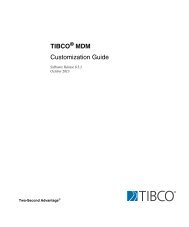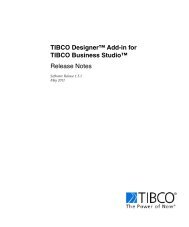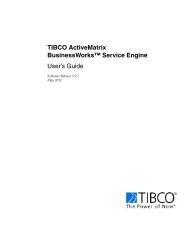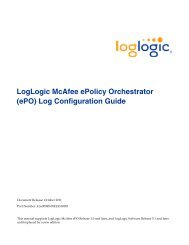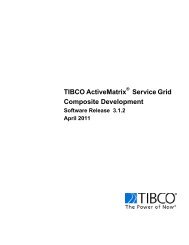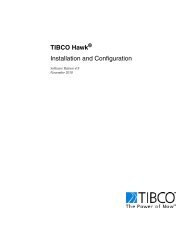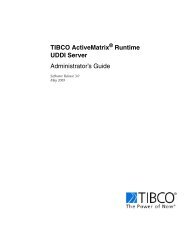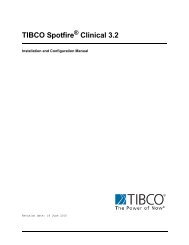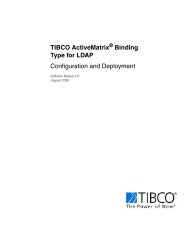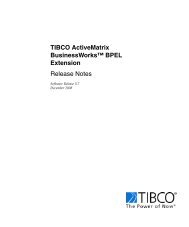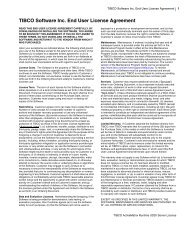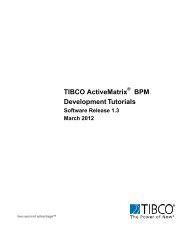TIBCO Spotfire Server 3.2.2 - TIBCO Product Documentation
TIBCO Spotfire Server 3.2.2 - TIBCO Product Documentation
TIBCO Spotfire Server 3.2.2 - TIBCO Product Documentation
Create successful ePaper yourself
Turn your PDF publications into a flip-book with our unique Google optimized e-Paper software.
Installing <strong>Spotfire</strong> <strong>Server</strong> 3.2<br />
Click Next.<br />
7 The Installation Folder is displayed. Specify where you want to install the previously<br />
selected component(s). Click Next.<br />
8 The OS Architecture dialog is displayed. Select whether you want to install the 32-bit<br />
or 64-bit version of <strong>TIBCO</strong> <strong>Spotfire</strong> <strong>Server</strong>.<br />
The 64-bit version can only be installed on a 64-bit operating system. The 32-bit<br />
Windows and Solaris version can be installed on either a 64-bit or a 32-bit operating<br />
system. The 32-bit Red Hat and SUSE versions can only be installed on 32-bit Red<br />
Hat and SUSE systems.<br />
Note: The version of <strong>Spotfire</strong> <strong>Server</strong> you select to install must match the version of<br />
database drivers it uses. All JDBC database drivers packaged with the <strong>Spotfire</strong> <strong>Server</strong><br />
exist in both 32-bit and 64-bit versions. If you intend to configure the <strong>Spotfire</strong> <strong>Server</strong><br />
to use ODBC Data Sources (as Information Services Data Sources), please note that<br />
while the <strong>Spotfire</strong> <strong>Server</strong> comes bundled with a 32-bit only Oracle (Sun) JDBC-<br />
ODBC bridge, it is recommended that this bridge is used for testing only. For<br />
production use, a commercial JDBC-ODBC bridge should be used. If you intend to<br />
use the bundled JDBC-ODBC bridge, you must install the 32-bit version of the<br />
<strong>Spotfire</strong> <strong>Server</strong>. If unsure, select 32-bit.<br />
Click Next.<br />
9 Windows only. The Windows Service dialog is displayed. You have three options:<br />
• Do not create Windows Service.<br />
• Create Windows Service, but do not start it.<br />
• Create Windows Service, and start it at the end of installation.<br />
Select the option you want and click Next.<br />
10 The <strong>Spotfire</strong> <strong>Server</strong> Ports dialog is displayed. Specify which ports you want the<br />
<strong>Spotfire</strong> <strong>Server</strong> and the <strong>Spotfire</strong> controller to communicate on. Click Next.<br />
11 If you have selected to also install the configuration console, the Configuration Port<br />
dialog is displayed. Specify which port you want the configuration console to<br />
communicate on. Click Next.<br />
12 The Installation Summary dialog is displayed. Click Install.<br />
Response: The installation starts.<br />
13 The Upgrade dialog is displayed. If you are performing an upgrade from 3.0 or 3.1 to<br />
3.2, you can select to start the upgrade tool automatically when the installer finishes.<br />
Check the box if you want to do this.<br />
14 The Install Complete dialog is displayed. Click Done.<br />
<strong>TIBCO</strong> <strong>Spotfire</strong>® <strong>Server</strong> <strong>3.2.2</strong> 25 (144)



